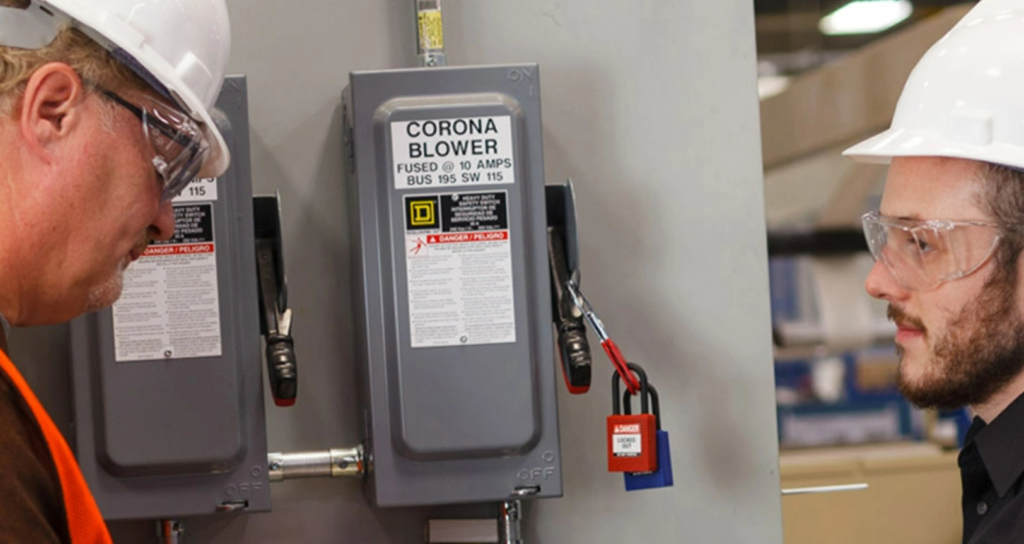Online Lockout / Tagout Training
Program
- WHMIS 2015
- Fall Protection
- Transportation Dangerous Goods
- Lift Truck / Forklift
- Aerial Lift
- Lockout / Tagout
- Fire Safety
- Dental WHMIS
- Confined Space
- H2S
- Ladder Safety
- Due Diligence
- Office Ergonomics
- Manual Material Handling
- Workplace Violence & Harassment
- Incident Investigation
- Workplace Inspections
- Worker Safety Awareness
- Supervisor Safety Awareness
Online Lockout / Tagout Training
REGISTRATION – Individual cost of this online Lockout/Tagout training program is only $39.00.
To Register ONLINE for the Lockout Tagout Training, simply use the convenient online shopping cart by selecting the adjacent “BUY NOW’ icon.
It will then directed you to our training catalogue – click on the course you would like to take and then follow the instructions.
You can take individually, or register as a company and create your own company Learning Management System(LMS). If you have any questions, please give us a shout at 416-283-7233 or Canada-wide toll free at 1-855-260-7233.
Register – New Customer :
Returning Customer, Sign-in Link :

Lockout Training Program
Failure to control the release of hazardous energy while servicing and maintaining equipment can cause some of the most severe injuries in our workplaces.
Modules
- Lockout and Definitions
- Hazardous Energy Control Program
- Lockout Devices and Steps to Lockout
- Lockout Processes
- Alternate Hazardous Energy Control Methods
View an Online LOCKOUT Training demo (click on start button below)
Alberta Legislation
Occupational Health and Safety Code
Section 212
If machinery, equipment, or powered mobile equipment needs service, repair, test, adjustment, or inspection, then an employer must ensure that a worker does not perform such work until the machinery, equipment, or powered mobile equipment has come to a complete stop.
Section 213
British Columbia Legislation
Occupational Health and Safety Regulation
Section 10.2
“If the unexpected energization or startup of machinery or equipment or the unexpected release of an energy source could cause injury, then the energy source must be isolated and effectively controlled.”
Section 10.3
Manitoba Legislation
New Workplace Health and Safety Regulations
Section 16.14
New Brunswick Legislation
New Brunswick Regulations 91-191
Section 239
“An employer shall establish a written lock out procedure for a machine and thereby ensure that an employee who may have to lock out a machine has been adequately trained to lock out the machine.”
Newfoundland/Labrador Legislation
Occupational Health and Safety Regulations
Section 128
Section 129
2. Where machinery or equipment is in use for normal production work, subsection (1) applies whenever a work activity creates a risk of injury to workers from the movement of the machinery or equipment, or exposure to an energy source, and the machinery or equipment is not effectively safeguarded to protect the workers from the risk.
Ontario Legislation
Occupational Health and Safety Act
Section 42(1)
“Disconnect the power supply to electrical installations, equipment, or conductors, and lock out and tag them before doing any work on or near live exposed parts of the installations, equipment, or conductors, and while you are carrying out the work.”
Section 75
“Perform cleaning, oiling, adjusting, repairing, or maintenance work on a part of a machine, transmission machinery, device, or thing only when (a) the motion that may endanger a worker is in stop; and (b) you have blocked any part that’s at stop and may subsequently move and endanger a worker to prevent its movement.”
Section 30.7
1. Where machinery or equipment is shut down for cleaning, maintenance or repairs, the employer shall ensure that no employee carries out work on the machinery or equipment until that employee has
(a) firstly, locked out the source of energy using the safety lock and key that the employer must provide under section 30.6; and
(b) then, put the machine in a zero energy state by ensuring that all (i) power sources, (ii) pressurized fluids and air,
(iii) potential mechanical energy,
(iv) accumulators and air surge tanks,
(v) kinetic energy of machine members,
(vi) lastly, loose or freely movable machine members, and
(vii) material or work pieces supported, retained or controlled by the machine which can move or cause movement



